My Eating Habits as a Kid
I don’t have a huge recollection of being a picky eater as a kid. However, I do remember snippets of things that led me to believe that perhaps I was a tad picky. I remember eating lots of grilled cheese sandwiches, macaroni and cheese, and egg sandwiches.
I remember never liking beef or pork and begging to not have to eat it. Also, I remember always (always) hearing my dad tell me that I needed to finish my dinner because there were starving kids in other places around the world who would love to have my meal.
When I was feeling like an extra hostile child, I recall saying, “Send it to them then.” I remember my leftover plate being kept for me so an hour later when I wanted a snack, it would happily be warmed up for me.
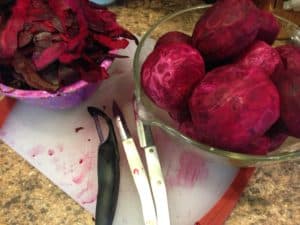 I also remember holiday dinners at my grandmother’s house where it was a requirement to “try a little bit of everything.” She even made me try the beets. Those blasted beets, sometimes pickled, sometimes not … but they always had nasty red juice that ran all over everything else. I always had to “try them” and I always hated it.
I also remember holiday dinners at my grandmother’s house where it was a requirement to “try a little bit of everything.” She even made me try the beets. Those blasted beets, sometimes pickled, sometimes not … but they always had nasty red juice that ran all over everything else. I always had to “try them” and I always hated it.
I Still Don’t Like Beets
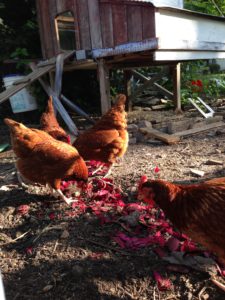 Luckily, I grew out of most of those things, and today I eat almost everything. I am not picky at all, there is just a small handful of things I really don’t care for. In no particular order, this small list includes caviar, wasabi, tofu, quinoa, pureed vegetables (this includes many soups), and beets. Those blasted beets. This is one I did not grow out of.
Luckily, I grew out of most of those things, and today I eat almost everything. I am not picky at all, there is just a small handful of things I really don’t care for. In no particular order, this small list includes caviar, wasabi, tofu, quinoa, pureed vegetables (this includes many soups), and beets. Those blasted beets. This is one I did not grow out of.
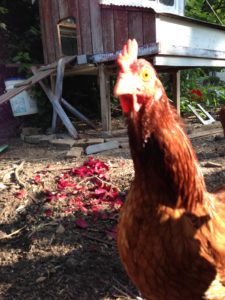 However, since I am now a mature adult, I will eat them … if I have to. I’ve had them cubed small and cooked well with butter, salt, and pepper on them and I have to admit they weren’t awful. You can just plain forget pickled beets though.
However, since I am now a mature adult, I will eat them … if I have to. I’ve had them cubed small and cooked well with butter, salt, and pepper on them and I have to admit they weren’t awful. You can just plain forget pickled beets though.
Beets are So Healthy for You
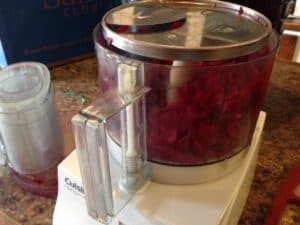 I have read in quite a few places recently how healthy they are for you, they have all kinds of vitamins in them and do great things for your health like help lower blood pressure, reduce the risk of heart disease, increase your brainpower, help your liver, aid digestion, and more. (Health Magazine is one source.) So, due to a combination of my aspiring to eat healthy things and be healthy, and my interest in trying new food preservation techniques that I haven’t tried before, I tried a new thing this week: dehydrated beets to grind for beet powder.
I have read in quite a few places recently how healthy they are for you, they have all kinds of vitamins in them and do great things for your health like help lower blood pressure, reduce the risk of heart disease, increase your brainpower, help your liver, aid digestion, and more. (Health Magazine is one source.) So, due to a combination of my aspiring to eat healthy things and be healthy, and my interest in trying new food preservation techniques that I haven’t tried before, I tried a new thing this week: dehydrated beets to grind for beet powder.
Making Dehydrated Beet Powder
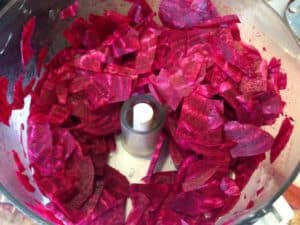 The goal here was to get the beet into a form that I would hopefully successfully be able to hide in my food. According to One Green Planet, 1 teaspoon of beet powder has all of the nutrients of 1 beet! Judging by how one of my dehydrated nuggets tastes, I’m really not sure if I can hide this flavor or not – but regardless. it was something new to try. And, my husband and I try really hard not to waste food – so we will use this beet powder that I made from these blasted beets, one way or another.
The goal here was to get the beet into a form that I would hopefully successfully be able to hide in my food. According to One Green Planet, 1 teaspoon of beet powder has all of the nutrients of 1 beet! Judging by how one of my dehydrated nuggets tastes, I’m really not sure if I can hide this flavor or not – but regardless. it was something new to try. And, my husband and I try really hard not to waste food – so we will use this beet powder that I made from these blasted beets, one way or another.
Anyway, the process was quite simple, albeit time-consuming. I cleaned the beets and cut off the tops and peeled them. I gave these scraps to my four hen chickens, who thought they were amazing.
Some Tools I Used for the Project
A couple of the gadgets and accessories you see here in the photos include my Norwex Veggie & Fruit Scrub Cloth, which works awesome for potatoes, beets, cucumbers, and more; and Cutco knives and vegetable peeler. These aren’t paid links, just sharing the products I use and love!
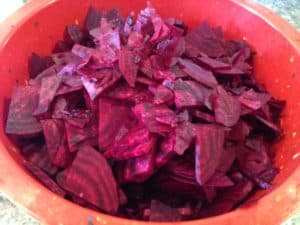 Then, I took the clean, peeled beets and quartered them, so they would fit in the chute of my Cuisinart Food Processor.
Then, I took the clean, peeled beets and quartered them, so they would fit in the chute of my Cuisinart Food Processor.
I have an older medium-sized model that I bought used about 10 years ago, and I have gotten my money’s worth on this thing so many times over. I love this thing and use it SO MUCH. Anyway, I put the slicing blade on it (which I also use to cut and freeze my garden potatoes) and ran the beets through it.
Ready for the Dehydrator
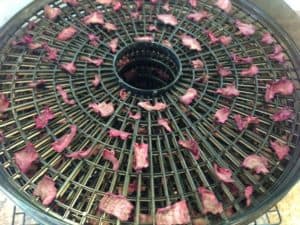 Once I was done with that, I put them on the dehydrator. For the first batch, I laid them all on the trays carefully and evenly, making sure they were not touching each other or overlapping at all. I totally underestimated how much they would shrink – I always forget this about the dehydrating process. Anyway, when I got all of the slices laid out perfectly on my five dehydrator trays, I had about 3/4 of my beet slices left. I put them in an airtight container in the fridge while the first batch dehydrated.
Once I was done with that, I put them on the dehydrator. For the first batch, I laid them all on the trays carefully and evenly, making sure they were not touching each other or overlapping at all. I totally underestimated how much they would shrink – I always forget this about the dehydrating process. Anyway, when I got all of the slices laid out perfectly on my five dehydrator trays, I had about 3/4 of my beet slices left. I put them in an airtight container in the fridge while the first batch dehydrated.
The First Batch
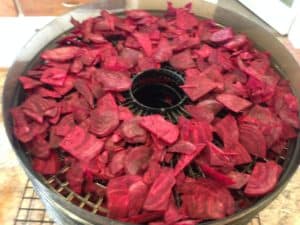 The first batch was in the dehydrator for about 8 hours. With it being the middle of summer, I have a tiny ant problem in my kitchen at the moment (a bit more about that below, stay tuned), so I actually put the first batch in an airtight container in the freezer temporarily – while I waited for the second batch to get done. Why the freezer? I didn’t feel like they were 100% dried and I wanted to throw them back on the dehydrator at the end of 2nd batch – so I didn’t want to put them in an airtight container at room temperature. Mold = bad.
The first batch was in the dehydrator for about 8 hours. With it being the middle of summer, I have a tiny ant problem in my kitchen at the moment (a bit more about that below, stay tuned), so I actually put the first batch in an airtight container in the freezer temporarily – while I waited for the second batch to get done. Why the freezer? I didn’t feel like they were 100% dried and I wanted to throw them back on the dehydrator at the end of 2nd batch – so I didn’t want to put them in an airtight container at room temperature. Mold = bad.
The Second Batch
For the second batch – I just threw the slices on the trays in a big pile. I didn’t worry about placement or overlapping or anything. (I did save about 2 cups of them sliced and ready to cook in the fridge for my husband to cook and eat because even though I don’t like them and hate the smell they make while they cook, he shouldn’t have to suffer. See how nice I am?)
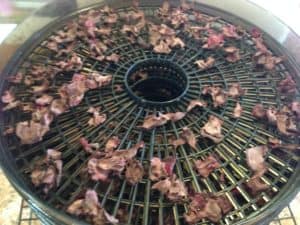 So, the second batch, since they were just haphazardly thrown on there, were in the dehydrator for about 20 hours. Guess what? When the 20 hours were over, the second batch turned out EXACTLY the same way as the first. So, this is NOT a project where being precise in the placement on the dehydrator trays matters, at all.
So, the second batch, since they were just haphazardly thrown on there, were in the dehydrator for about 20 hours. Guess what? When the 20 hours were over, the second batch turned out EXACTLY the same way as the first. So, this is NOT a project where being precise in the placement on the dehydrator trays matters, at all.
We Almost Have Beet Powder!
 When all of them were done, I put them on a baking sheet. After that, I decided they could still use a tad more drying, so I put the cookie sheet in my oven at 170 degrees for about 2 hours (rotating them around every 30 minutes.) I would have done it at 120-140 degrees, but unfortunately, my oven only goes down to 170. Something to keep in mind next time I am oven shopping!
When all of them were done, I put them on a baking sheet. After that, I decided they could still use a tad more drying, so I put the cookie sheet in my oven at 170 degrees for about 2 hours (rotating them around every 30 minutes.) I would have done it at 120-140 degrees, but unfortunately, my oven only goes down to 170. Something to keep in mind next time I am oven shopping!
Grinding the Chips into Beet Powder
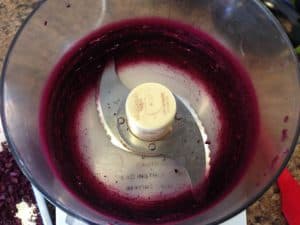 When they were all done, I let them cool completely, and pulsed them in my trusty Cuisinart Food Processor – but with the regular pulsing blade this time. This didn’t work out exactly as I had planned – it didn’t turn into total powder but more like small granules. I think maybe they just weren’t quite dry enough yet.
When they were all done, I let them cool completely, and pulsed them in my trusty Cuisinart Food Processor – but with the regular pulsing blade this time. This didn’t work out exactly as I had planned – it didn’t turn into total powder but more like small granules. I think maybe they just weren’t quite dry enough yet.
Anyway at this point, I was three days into the process and honestly was kind of over it, so I called it good. I will store my beet “granules” in the freezer (I’m kind of a paranoid dehydrator – I am always worried my stuff is going to still have moisture left and grow mold. The beauty of this is once things are dehydrated they take up barely any freezer space.)
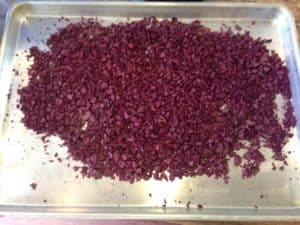 So, the bucket of beets that I showed at the top of the post ended up yielding the small bowl I saved for my husband to cook and eat + this quart bag of beet granules. Dehydrating is a pretty amazing space saver, I’d say!
So, the bucket of beets that I showed at the top of the post ended up yielding the small bowl I saved for my husband to cook and eat + this quart bag of beet granules. Dehydrating is a pretty amazing space saver, I’d say!
Now … I promised a bit more info on the ants. It seems like about once a summer, we get an infestation of these tiny ants, I suppose maybe they are kitchen ants but I’m not sure.
A Sidenote about Kitchen Ants
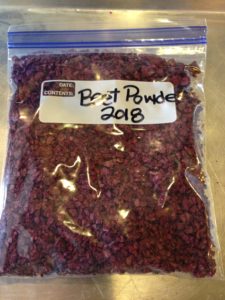 We keep our dog, cat, and chicken food in airtight pet food containers, but these little buggers can get in anyway. It always seems to be the dog food they hit first. Usually, I go out and buy some of the ant houses, but I was hoping to stay away from those this year due to their ingredients.
We keep our dog, cat, and chicken food in airtight pet food containers, but these little buggers can get in anyway. It always seems to be the dog food they hit first. Usually, I go out and buy some of the ant houses, but I was hoping to stay away from those this year due to their ingredients.
In my research, I read that cornstarch can get rid of them because they eat it and it makes them explode (which makes me sad, but … I mean, ants in the kitchen, come on.) I also read that cayenne pepper deters them. Another tip was that vinegar and lemon/citrus essential oils deter them. Guys, I’ve tried it all. I finally even (cringe) bought a box of the ant houses. Note: Be sure to carefully place them out of pets’ reach and away from food. I still have some ants. but I think they are dwindling.
But, while the beets were dehydrating I noticed it was drawing some ant attention. I put the dehydrator up on a cooling rack to get it off the counter and sprinkled the counter with cornstarch and cayenne pepper. This kept them away from the dehydrator during this process. Here are some more natural ant-controlling tips from Farmer’s Almanac. I think I will be trying a few more of these. I don’t want to KILL the ants (they are pollinators after all), I just don’t want them to live in my kitchen.
Project Complete!
 Anyway, my overall review of this beet dehydrating process to get beet powder? It took a bunch of time and it didn’t turn out 100% as I anticipated in the end. But, I do like trying new things and it was an interesting process. And, we will eat it, one way or another. So, I call it a success!
Anyway, my overall review of this beet dehydrating process to get beet powder? It took a bunch of time and it didn’t turn out 100% as I anticipated in the end. But, I do like trying new things and it was an interesting process. And, we will eat it, one way or another. So, I call it a success!
If you give dehydrating beet powder a try, I’d love to hear about it in the comments!
Oh, this guy here is Bill. He loves almost every vegetable you feed him. He thinks the beets are dee-licious.
If you liked this blog post, you might also enjoy these posts:
For more blog posts like this one, click here.

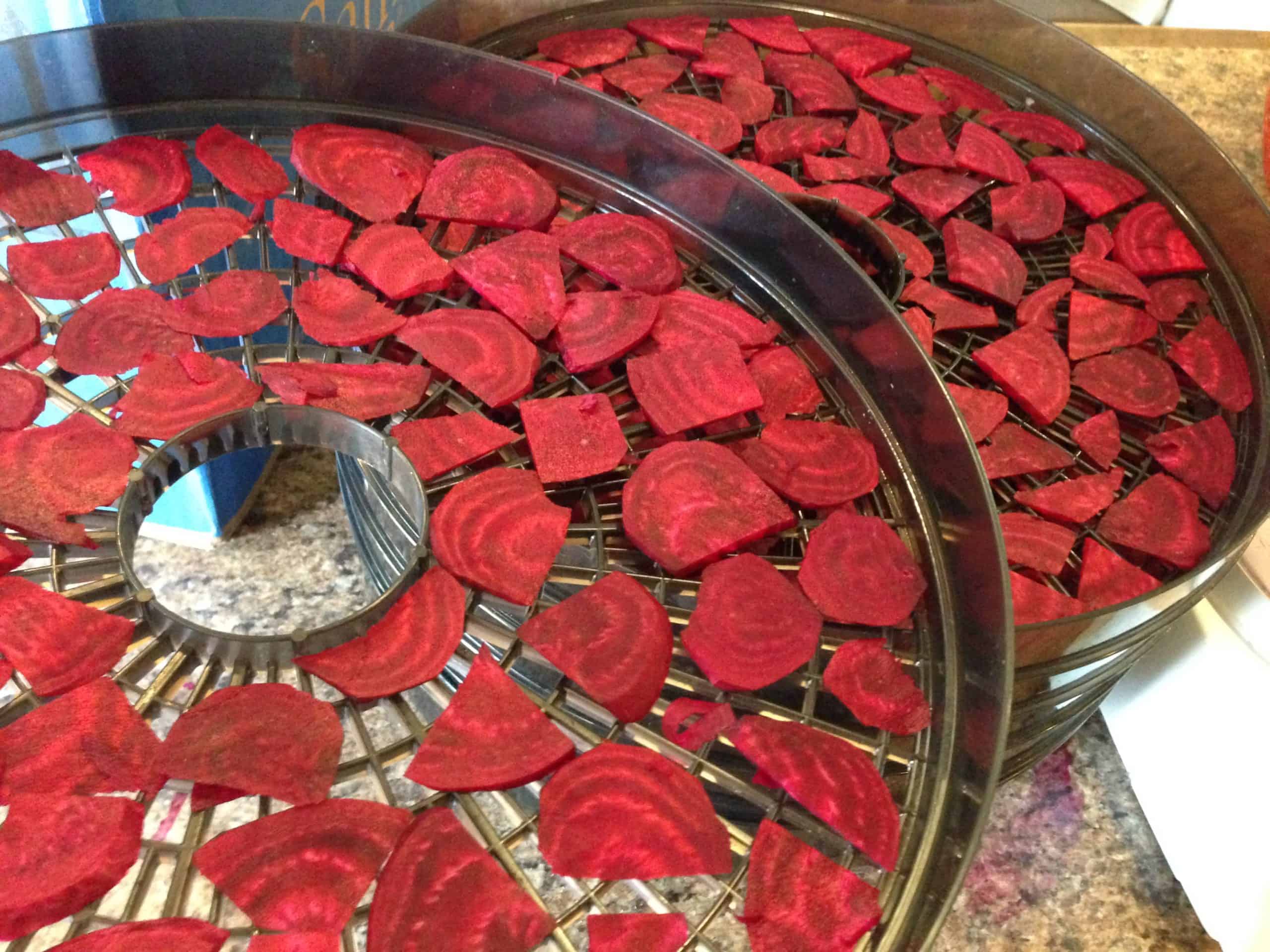
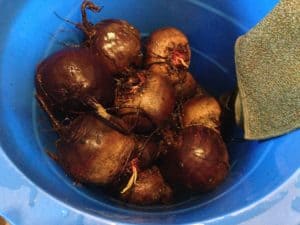
I am planning on making beer powder for food dye. My daughter does not allow red dye in the kids food. Which has really helped with uncontrolled behavior problem.
We eat organic unprocessed so going to use to add color to homemade corned beef. What they use for color is used to make fireworks. So healthy route we go. Plus we don’t buy processed with all the additives.
I am going to first bake beets in oven method. So much less work than peeling. Skins come off with a paper towel. Then slice then dehydrate. Thank you for times and temperatures.
Hi Carol! Oh that’s a great idea for a food dye replacement. I’ve seen some really pretty dyed Easter eggs using beet powder, turmeric, etc. I hope your powder turns out great!
I found this article fun to read & helpful. Thank you!
Thanks so much, Julie! I’m glad you enjoyed it. Thanks for reading. 🙂